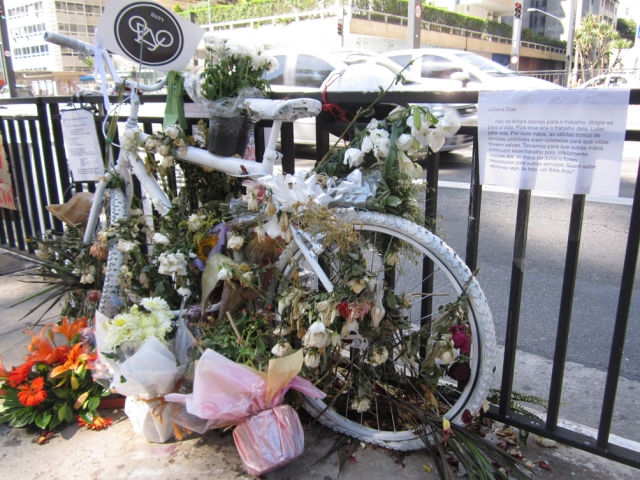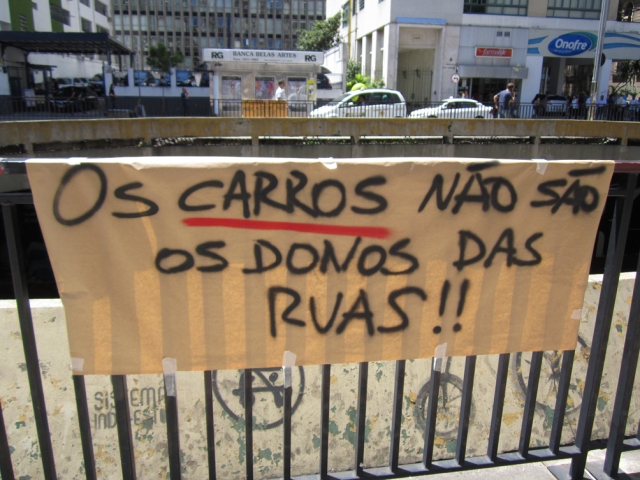On the morning of March 2, 2012, 33-year-old Juliana Dias was killed [1] by a bus while riding her bicycle on her way to work along São Paulo's main street, Avenida Paulista. Her story shocked cycling rights activists, sparked spontaneous protests across the city and opened a national debate.
The blog Beirut Walls [2] [ar] described the sad accident:
كانت جولي تسير على الجهة الصحيحية كما تفعل كل يوم وهي في طريقها الى العمل، بين الجهة المتعارف عليها للباص والجهة المخصصة لمرور السيارات. ضايقتها سيارة وكسرت عليها. فعل معها الأمر نفسه سائق باص، فاحتجت. أصرّ سائق الباص بالمضايقة فأوقعها أرضاً عن قصد، ليأتي باص ثاني ويدهس رأسها.
يقول أهالي منطقة باوليستا أن السائق الذي دهسها، ولم يكن ذلك ذنبه، كان صديقها بالسير؛ فهم كانوا يتبادلون التحية كل صباح عند ما يلتقون في الطريق.
تم سجن سائق الباص الأول بتهمة القتل الغير متعمد.
Julie was cycling on the correct side as she did every day on her way to work, between the bus and car lanes. A car harassed her and steered over to her lane. The same thing happened with a bus driver, and she protested. The bus driver insisted on harassing her, and made her fall down, and the next bus ran over her head.
Paulista area residents say that the driver who ran over Juliana (which was not his fault) was her friend; they exchanged greetings every morning when they met in the street.
The first bus driver has been arrested, accused of non-intentional homicide.
According to São Paulo’s transit authority data [3] [pt] from 2010, one cyclist a week dies in a traffic accident in São Paulo.
Leonardo Sakamoto, a professor of journalism at São Paulo's PUC university, wrote on his blog [4] [pt]:
Mais uma ciclista morreu atropelada em São Paulo. Novamente por um ônibus, novamente na via que é o símbolo do progresso, novamente gerando um protesto de pessoas que defendem que a cidade pertença a todos. E, novamente, criando indignação pelo congestionamento que tudo isso trouxe.
Cars are not the owners of the roads
Beirut Walls [2] [ar] blog wrote a summary of the last events concerning the legalisation and municipalities approval of cycling rights on streets:
في العام ٢٠١١ أخفض كساب الميزانية المخصصة للنقل العام الى نصف ما كانت عليه في الـ ٢٠١٠ ومع ذلك وعد كساب عندما تولى منصب رئيس بلدية ساو باولو في عام 2009، ببناء 100 كيلومتر من مسارات الدراجات والممرات. حتى الآن، تم فتح 76 كم، ولكن 20٪ فقط من لهم علاقة بالبنية التحتية محددة لراكبي الدراجات وذلك في خامس أكبر مدينة في العالم حيث عدد السكان يتجاوز العشرة ملايين، وحيث عدد السيارات الخصوصية عالي جدا بالنسبة للمدينة مما يؤدي إلى عرقلة حركة السير وتأخير المواصلات العامة. في 7 مارس/آذار 2012 أقر كساب القانون الذي يؤسس لإنشاء نظام سير للدراجات الهوائية يتضمن طرق، ممرات ومسارات خاصة للدراجة وأماكن مخصصة لركنها.
Moreover, on February 17, the blog Eu vou de Bike [7] (I'm going by bike) [pt], published some good news for cyclists:
A melhor notícia da semana para quem mora em São Paulo foi divulgada sem muito alarde na última quarta-feira. Segundo reportagem da Folha de S. Paulo, a cidade vai receber um sistema de compartilhamento com TRÊS MIL bicicletas espalhadas por 300 estações
A set of photos [8] was posted on the Beirut Walls blog as a way to protest and promote the case of cyclists in São Paulo city:
 [2]
[2]Let me use the bicycle as a means of transport / Only bikes save / Your car and your hurry can kill / 60 km per hour in Paulista is a crime. Source Beirut Walls blog (used with permission)
Furthermore, the blog Cidades para pessoas [9] (Cities for the people) [pt] suggests a creative idea for raising awareness about bicycle rights in the city, by mapping bicycle accidents in São Paulo:
A proposta de criação desse mapa colaborativo foi postada na plataforma Cidade Democrática, onde podemos recrutar mais ajudantes para aperfeiçoá-lo. Com o tempo esse mapa vai se tornar um documento informal e pode ser usado como instrumento de demanda por mais segurança para os ciclistas ao poder público – além de ser um importante registro democrático e transparente dos acidentes na cidade. Em uma pesquisa encontramos mapas existentes que já mapearam os acidentes fatais envolvendo ciclistas em São Paulo nos anos de 2006, 2007 e 2008. Por isso é importante que juntemos esforços para tentar levantar os acidentes a partir de 2009.

